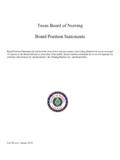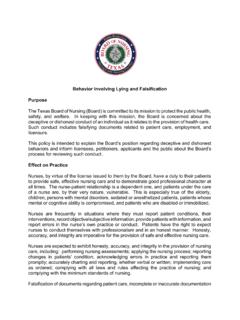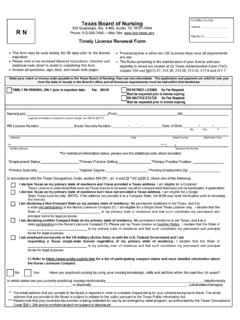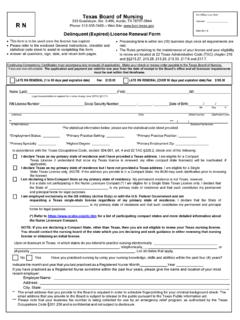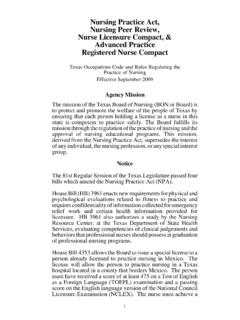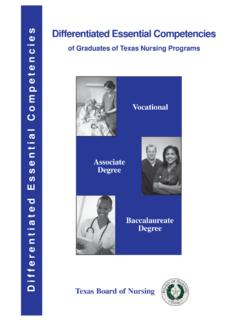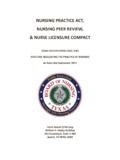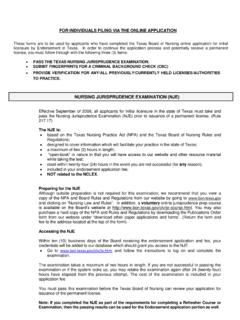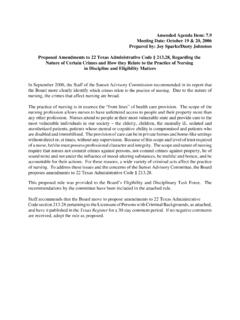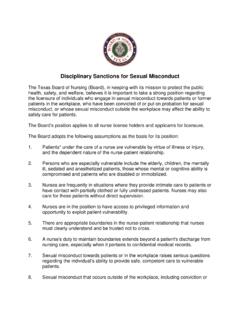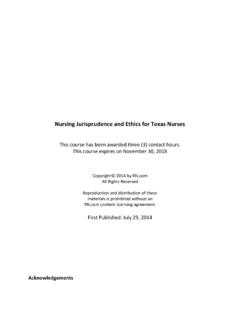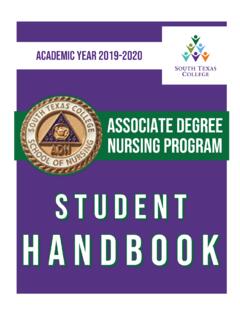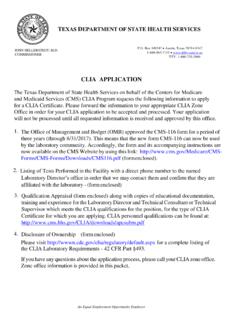Transcription of Texas Board of Nursing Board Position Statements
1 Texas Board of Nursing Board Position Statements Board Position Statements do not have the force of law, but are a means of providing direction for nurses on issues of concern to the Board relevant to protection of the public. Each Position statement is meant to provide guidance in the context of the totality of the Position statement. Board Position Statements are reviewed annually for relevance and accuracy to current practice, the Nursing Practice Act, and Board rules. Last Review: January 2019 Texas Board of Nursing Position Statement 333 Guadalupe #3-460 Austin, Texas 78701 (512) 305-6802 Page: 2 2 Position Statements Nurses Carrying out Orders from Physician's Assistants p.
2 4 The Role of the Licensed Vocational Nurse in the Pronouncement of Death p. 5 LVNs Engaging in Intravenous Therapy, Venipuncture, or PICC Lines p. 7 Educational Mobility p. 10 Nurses with Responsibility for Initiating Physician Standing Orders p. 11 Board Rules Associated with Alleged Patient Abandonment p. 14 The Role of LVNs & RNs in Management and/or Administration of Medications via Epidural or Intrathecal Catheter Routes p. 19 Role of the Nurse in Moderate Sedation p. 22 Performance of Laser Therapy by RNs or LVNs p. 28 Continuing Education: Limitations for Expanding Scope of Practice p.
3 30 Delegated Medical Acts p. 32 Use of American Psychiatric Association Diagnoses by LVNs, RN or APRNs p. 33 Role of LVNs and RNs in School Health p. 34 Duty of a Nurse in any Practice Setting p. 36 Board 's Jurisdiction over a Nurse's Practice in Any Role and Use of the Nursing Title p. 38 Development of Nursing Education Programs p. 40 Texas Board of Nursing / Board of Pharmacy, Joint Position Statement, Medication Errors p. 42 Nurses Carrying out Orders from Advance Practice Registered Nurses p. 45 Nurses Carrying out Orders from Pharmacists for Drug Therapy Management p. 46 Registered Nurses in the Management of an Unwitnessed Arrest in a Resident in a Long Term Care Facility p.
4 48 [Deleted 01/2005] p. 52 Texas Board of Nursing Position Statement 333 Guadalupe #3-460 Austin, Texas 78701 (512) 305-6802 Page: 3 3 APRNs Providing Medical Aspects of Care for Individuals with whom there is a Close Personal Relationship p. 53 The use of Complementary modalities by the LVN or RN p. 54 Nurses Engaging In Reinsertion of Permanently Placed Feeding Tubes p. 57 Administration of Medication & Treatments by LVNs p. 59 [Deleted 01/2015] p. 61 The Licensed Vocational Nurse Scope of Practice p.
5 62 The Registered Nurse Scope of Practice p. 74 Professional Boundaries including Use of Social Media by Nurses p. 85 Workplace Violence p. 89 Texas Board of Nursing Position Statement 333 Guadalupe #3-460 Austin, Texas 78701 (512) 305-6802 Page: 4 4 Nurses Carrying Out Orders from Physician Assistants The purpose of this Position statement is to provide guidance to nurses with regard to carrying out orders from Physician Assistants (PAs). The Nursing Practice Act (NPA) includes the "administration of medications or treatments ordered by a physician, podiatrist or dentist" as part of the practice of ,2 There are no other healthcare professionals listed thus leading to questions regarding nurses carrying out orders from other licensed healthcare providers.
6 Although PAs are not included in the NPA, the Board recognizes that nurses work collaboratively with PAs to provide patient care in various practice settings. The PA is licensed and regulated by the Texas Physician Assistant P As may provide medical aspects of care, including ordering or prescribing medications and treatments, as delegated by a physician consistent with laws, rules and regulations applicable to the PAs practice including those of the Texas Medical Board (TMB) Chapter A physician is not required to be present at all times at the location where the PA is providing care and orders are not required to be countersigned by the physician. A nurse may carry out these orders.
7 As with any order, the nurse must seek clarification if he/she believes the order or treatment is inaccurate, non-efficacious or contraindicated by consulting with the PA and physician as A list of physician assistants credentialed by the medical staff and policies directing their practice should be available to the Nursing staff. 1 Nursing Practice Act, TOC (2) 2 Texas Board of Nursing (2017). Position statement , Administration of Medication & Treatments by LVNs. 3 Physician Assistant Licensing Act, TOC Chapter 204 and 22 TAC Chapter 185 4 22 TAC (17); , (17) & (18) 5 22 TAC (1)(N) ( Board Action: 01/1994; Revised: 01/2005; 01/2006; 01/2010; 01/2012; 01/2016; 01/2017; 01/2018) (Reviewed: 01/2007; 01/2008; 01/2009; 01/2011; 01/2013; 01/2014; 01/2015.)
8 01/2019) Texas Board of Nursing Position Statement 333 Guadalupe #3-460 Austin, Texas 78701 (512) 305-6802 Page: 5 5 The Role of the Licensed Vocational Nurse in the Pronouncement of Death Licensed vocational nurses (LVNs) do not have the authority to legally determine death, diagnose death, or otherwise pronounce death in the State of Texas . Regardless of practice setting, the importance of initiating cardiopulmonary resuscitation (CPR) in cases where no clear do-not-resuscitate (DNR) orders exist is imperative. The Board of Nursing (BON) has investigated cases involving the failure of a LVN to initiate CPR in the absence of a DNR order.
9 Position Statement , Registered Nurses in the Management of an Unwitnessed Arrest in a Resident in a Long Term Care Facility, has additional information in regards to imitating CPR. It is within the LVN scope of practice as defined by 22 TAC (1)-(2) (effective 9/28/2004) and Position Statement , The Licensed Vocational Nurse Scope of Practice, for a LVN to gather data and perform a focused assessment regarding a patient, to recognize significant changes in a patient s condition, and to report said data and observation of significant changes to the physician. The LVN s focused assessment should include Nursing observations to determine the presence or absence of the following presumptive or conclusive signs of death: Presumptive Signs of Death The patient is unresponsive, The patient has no respirations, The patient has no pulse, The patient s pupils are fixed and dilated, The patient s body temperature indicates hypothermia: skin is cold relative to the patient s baseline skin temperature, The patient has generalized cyanosis, and Conclusive Signs of Death There is presence of livor mortis (venous pooling of blood in dependent body parts causing purple discoloration of the skin).
10 While these signs of irreversible death would not be expected to be seen in most practice settings, the American Heart Association also includes the following irreversible signs of death: o decapitation (separation of the head from the body) o decomposition (decay or putrification of the body) o rigor mortis (stiffness of the limbs and body that develops 2 - 4 hours after death and may take up to 12 hours to fully develop). Upon reporting clinical findings to the physician, and in accordance with facility policy, the LVN may accept reasonable physician s orders regarding the care of the client; : notification of family, postmortem care, Texas Board of Nursing Position Statement 333 Guadalupe #3-460 Austin, Texas 78701 (512) 305-6802 Page: 6 6 contacting the funeral home or appropriate legal authority, documentation.
